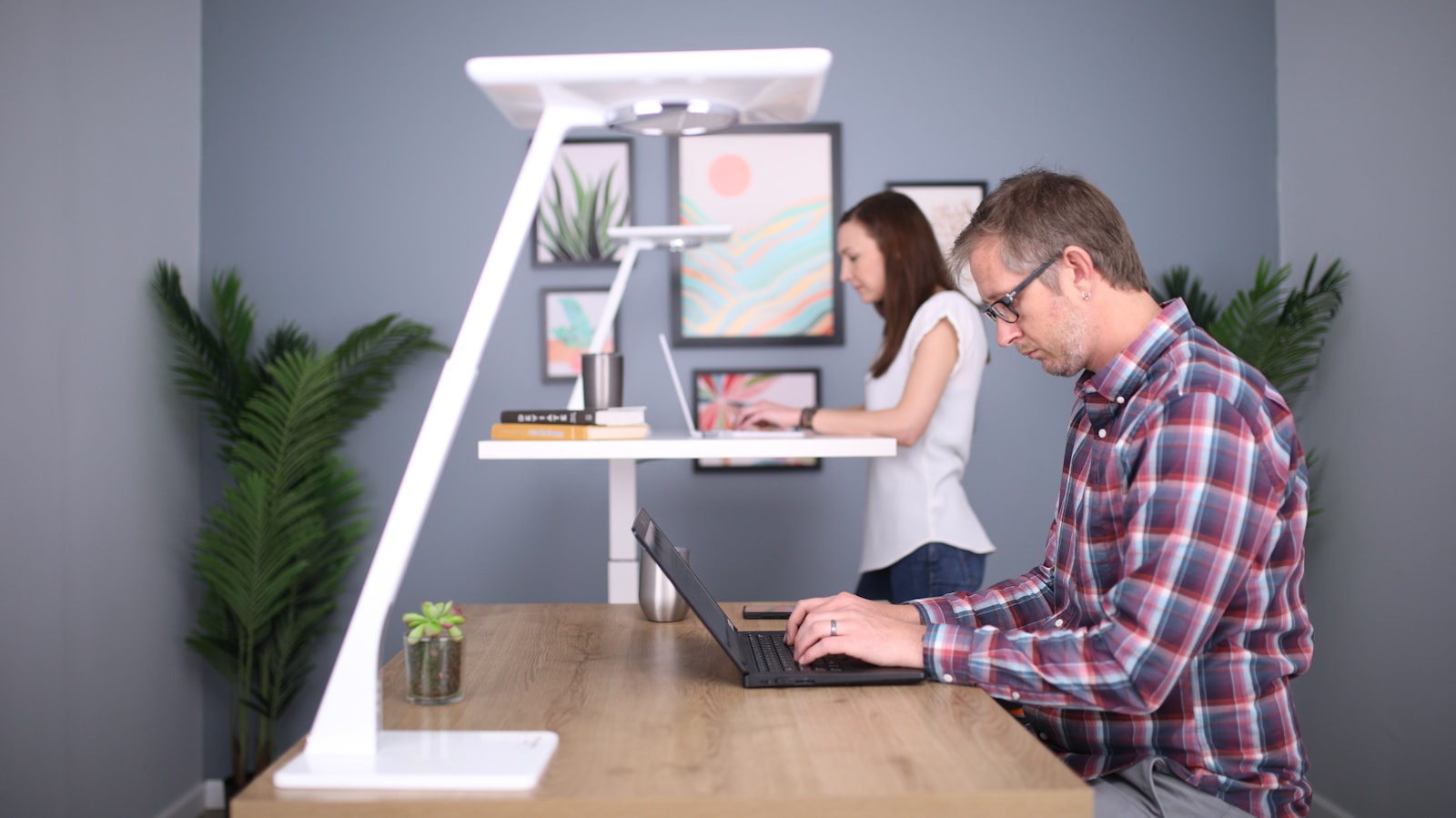The modern workplace often involves long hours of sitting, which has been linked to various health problems, from back pain to cardiovascular issues. Standing desks have emerged as a popular solution to combat the negative effects of prolonged sitting. This article explores 10 key benefits of using a standing desk for work, backed by science and practical experience.
- Reduces the Risk of Weight Gain and Obesity
One of the most significant benefits of using a standing desk is its role in preventing weight gain and promoting weight loss. Weight gain is primarily caused by consuming more calories than you burn. Standing burns more calories than sitting, even if you’re just standing still. On average, standing burns an extra 50 calories per hour compared to sitting. Over time, this difference can lead to significant health benefits and help in maintaining a healthy weight.
### Practical Tips for Maximizing Calorie Burn
- Incorporate Movement: Make a habit of pacing while on phone calls or doing calf raises periodically.
- Set Timers: Use a timer to remind yourself to stand up if you’re sitting, or to move around if you’ve been standing in one spot too long.
- Use a Stepper: Consider using a mini stepper or a balance board to add a bit more movement to your day.
### Real-World Example
Consider Jane, a graphic designer who integrated a standing desk into her daily routine. Over the course of six months, she noticed a modest weight loss of around 5 pounds, attributing it to her increased calorie expenditure from standing more often.
- Lowers the Risk of Heart Disease
Prolonged sitting has been linked to an increased risk of heart disease. Research dating back to the 1950s found that bus conductors who stood all day had half the risk of heart disease-related deaths compared to their colleagues who sat. Standing more during the day can help improve blood circulation and reduce the risk of cardiovascular issues.
### Steps to Improve Heart Health
- Alternate Between Sitting and Standing: Aim to change your position every 30 minutes to keep your blood flowing.
- Take Short Walks: Incorporate short walks throughout your workday, even if it’s just a walk to the water cooler or around your office.
- Practice Deep Breathing: This can help improve circulation and reduce stress, further benefiting heart health.
### Case Study: The Office Experiment
A tech company conducted a six-month experiment with standing desks and found that employees showed a 10% decrease in heart rate, indicating reduced strain on the heart and improved cardiovascular health.
- Reduces Back Pain
Back pain is one of the most common complaints among office workers who sit for long periods. Standing desks have been shown to be effective in reducing chronic back pain. Studies suggest that using a standing desk can significantly decrease lower back pain in workers who experience it due to prolonged sitting. Alternating between sitting and standing throughout the day helps relieve the pressure on the spine and promotes better posture.
### Tips for Alleviating Back Pain
- Ergonomic Setup: Ensure your standing desk is set up correctly, with the monitor at eye level and your arms at a 90-degree angle.
- Use an Anti-Fatigue Mat: This can help reduce discomfort and provide support for your feet and legs.
- Stretch Regularly: Incorporate stretches that target the lower back and hips to relieve tension.
### Personal Insight
From my years in the construction industry, I’ve seen firsthand how important it is to maintain a healthy back. Many colleagues who transitioned to standing desks reported a significant reduction in their back pain, allowing them to focus better on their work without the distraction of discomfort.
- Improves Mood and Energy Levels
Standing desks can positively impact your mood and energy levels. Several studies have shown that standing more throughout the day is associated with less stress and fatigue. In one study, participants who used standing desks reported feeling more energized and less stressed than those who remained seated all day. This boost in energy and mood can lead to increased productivity and overall well-being.
### Boosting Energy with Simple Changes
- Natural Light: Position your desk near a window to take advantage of natural light, which can improve mood and energy.
- Music or White Noise: Playing your favorite tunes or ambient sounds can enhance mood and reduce stress.
- Hydration: Keep a water bottle at your desk to remind yourself to stay hydrated, which is crucial for maintaining energy levels.
### Example from the Field
In a survey of remote workers who switched to standing desks, 65% reported feeling more engaged and less fatigued throughout their workday. This aligns with my observations in office environments where standing desks are prevalent.
- Boosts Productivity
Increased productivity is another benefit of standing desks. Some worry that standing could negatively affect focus, but research suggests otherwise. Employees using standing desks have reported improved concentration and task engagement. When combined with regular breaks and movement, standing can enhance alertness and efficiency, particularly for tasks that require creativity and collaboration.
### Recommendations for Enhancing Productivity
- Task Planning: Use the Pomodoro Technique to break work into intervals, alternating between sitting and standing.
- Collaborative Spaces: If possible, set up standing meeting areas to encourage quick and focused discussions.
- Use Tech Wisely: Employ apps that track your productivity and remind you to switch positions.
### Office Case Study: Productivity Enhancement
A marketing firm implemented standing desks and found a 15% increase in productivity over a year. Employees credited the standing desks for their ability to stay focused and energized, especially during long creative sessions.
- Improves Posture
Poor posture is a common issue among those who sit for extended periods. Hunched shoulders, slouched backs, and forward head positions are typical consequences of long hours spent sitting at a desk. Standing desks encourage better posture by promoting an upright position, reducing the likelihood of developing musculoskeletal problems. When using a standing desk, it’s important to adjust the desk height correctly and maintain proper posture to fully benefit from this feature.
### Tips for Maintaining Good Posture
- Desk Height: Adjust your desk so that your elbows are at a 90-degree angle and your screen is at eye level.
- Foot Position: Keep your feet flat on the ground or on a footrest to avoid strain.
- Core Engagement: Engage your core muscles while standing to maintain stability and posture.
### Real-Life Application
A friend of mine, who is a software developer, struggled with neck and shoulder pain due to poor posture. After switching to a standing desk, he noticed a marked improvement in his posture and a reduction in pain, which he attributes to better ergonomics and more frequent movement.
- Increases Longevity
Studies have linked prolonged sitting with a shorter lifespan due to its association with various health issues like obesity, heart disease, and type 2 diabetes. Reducing sedentary time by standing more frequently can contribute to a longer, healthier life. While standing alone won’t negate all the risks, it is a step toward better health, particularly when combined with regular exercise and a balanced diet.
### Strategies for a Longer, Healthier Life
- Balanced Routine: Combine standing with regular exercise and healthy eating habits.
- Monitor Health: Regular check-ups can help track the impact of lifestyle changes on health.
- Set Goals: Use health apps to set and track standing and movement goals.
### Example of Lifestyle Change
My neighbor, a retired teacher, incorporated standing desks and regular walks into her routine, significantly improving her health markers like blood pressure and weight, contributing to a more active and fulfilling retirement.
- Reduces the Risk of Type 2 Diabetes
Sitting for long periods has been linked to insulin resistance, a key factor in the development of type 2 diabetes. Standing after meals, particularly after lunch, can help stabilize blood sugar levels and improve insulin sensitivity. Studies have shown that workers who stand for part of their day experience lower blood sugar spikes compared to those who sit continuously.
### Managing Blood Sugar with Simple Adjustments
- Post-Meal Standing: Make it a habit to stand or take a short walk after meals to aid digestion and blood sugar control.
- Healthy Snacking: Keep low-glycemic snacks at your desk to maintain stable energy levels.
- Regular Monitoring: If you have diabetes, regular blood sugar monitoring can help assess the benefits of standing.
### Personal Experience
As someone who has managed type 2 diabetes, integrating standing desks and light post-meal walks into my routine has helped me maintain better control over my blood sugar levels, enhancing my overall health.
- Enhances Mental Focus
Standing desks have been shown to enhance cognitive function and mental focus. By reducing the physical fatigue associated with prolonged sitting, standing desks help keep your mind sharper and more alert. This is particularly beneficial for tasks that require sustained attention and problem-solving abilities. Additionally, standing promotes more movement, which increases blood flow to the brain, further enhancing cognitive performance.
### Techniques to Enhance Mental Focus
- Mindfulness Breaks: Incorporate short mindfulness or breathing exercises to clear your mind and improve focus.
- Ambient Stimulation: Use ambient sound apps to create a conducive work environment.
- Timed Work Sessions: Break your work into focused sessions with short breaks to maintain high levels of concentration.
### Cognitive Improvement Case Study
A study involving university students found that those who used standing desks during study sessions reported enhanced focus and retention of information, leading to improved academic performance.
- Promotes Active Habits and Movement
One of the major advantages of standing desks is that they naturally promote more movement throughout the day. When standing, you’re more likely to shift your weight, stretch, or walk around, which keeps your muscles engaged and reduces stiffness. Integrating light exercises, such as calf raises or leg stretches, while using a standing desk can further boost your physical activity levels during the workday.
### Encouraging More Movement
- Stretch Often: Set reminders to stretch or do light exercises throughout the day.
- Walking Meetings: Whenever possible, opt for walking meetings to combine movement with productivity.
- Active Breaks: Use breaks to engage in short, invigorating activities like jumping jacks or brisk walks.
### Personal Insight
In my own experience, integrating simple activities like desk yoga or quick walks into the workday has significantly improved my flexibility and reduced the stiffness that comes from sitting for long periods.
Using a standing desk offers numerous health benefits, from reducing back pain and improving posture to boosting energy levels and productivity. While standing all day isn’t the solution—balancing between sitting and standing, combined with regular movement and breaks, is key—a standing desk is a powerful tool in promoting a healthier, more active work environment. By incorporating a standing desk into your routine, you can enhance both your physical health and work performance in the long term.




